Most of the buildings in the private sector have basements for storing various products and home preservation products. Regardless of the purpose of the basement, which is being built below ground level, it is necessary to correctly ventilate to ensure the supply of fresh air to the cellar. Its presence will allow you to create the required microclimate and prevent the formation of dampness, which significantly reduces the shelf life of products. In addition, it will protect structural elements from excessive moisture, which gradually destroys the base of the structure.
Ventilation types
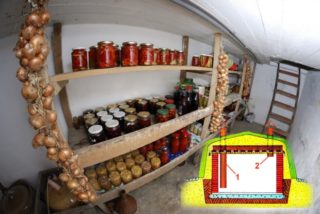
A separate extractor hood for the cellar, like all known ventilation systems, is organized in two ways: natural or forced. Their arrangement differs significantly in the applied constructive schemes and in the funds invested in them. Natural ventilation in the cellar is done in accordance with a typical project, according to which air enters it due to the temperature difference inside and outside. When using the second scheme, a pressure injection element is introduced into its composition, which is usually a fan.
Features of natural ventilation
Due to the always existing difference in the temperatures of the external and internal environment, a pressure gradient appears at their border, causing the movement of air masses. Thanks to this, fresh air from the street through the intake opening enters the basement and displaces its stubborn and musty masses through the outlet channel. The main elements of natural exhaust include the supply pipe, the exhaust duct, which removes air from the basement and the so-called "vents".
The inlet is equipped with a fine mesh that protects against dirt, foreign objects and rodents from entering the pipes, and the outlet is closed with a protective visor. To obtain the required draft, the basement ventilation is equipped in compliance with the following rules:
- First of all, the problem of creating the maximum height difference between the inlet and outlet holes is solved.
- You should also try to place them along the longitudinal diagonal of the basement (at opposite ends).
- The inlet is made at the bottom of one of the walls, and the hood is made in the upper part of the wall opposite the first.
For laying pipes and ducts of the exhaust system, standardized blanks of a suitable size are used.
The development of the contour of natural ventilation of basements in private houses in accordance with the current standards (SNiP) is carried out at the design stage. Based on the results of preliminary calculations, the throughput of pipes and ducts is calculated. In this case, the working volume of the serviced basement must be taken into account.
Forced draft systems
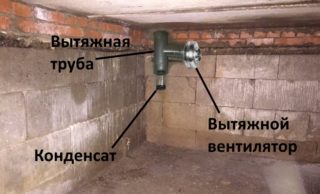
Forced extraction in the cellar functions by moving air masses driven by an external device, the function of which is usually performed by a fan. Its main components:
- air ducts through which air masses move;
- injection unit, through which air exchange of the required intensity is achieved;
- intake devices designed to maintain air circulation;
- connecting structures that combine air lines with various standard sizes of pipes and ducts.
Typical examples of the latter are tees used when it is necessary to combine or separate air flows. They also include extension cords and diffusers of various configurations. The forced ventilation system is additionally equipped with the following elements:
- special filters that purify the air pumped in from the outside;
- a heating unit designed to heat it;
- temperature control unit, set depending on the design features of the basement and customer requirements.
Forced draft equipment is prepared according to a pre-drawn diagram. Even at the design stage, the calculation of the system is carried out, according to the results of which the required intensity of air exchange is determined and the modes of its operation are selected.
Thanks to its extended functionality, forced ventilation has a number of advantages:
- independence from weather conditions;
- the presence of automation that allows you to effectively distribute air flows and choose the optimal temperature regime;
- the possibility of operation in basements of a large area.
The disadvantages of the forced type of ventilation include significant monetary costs associated with the purchase of ventilation and additional equipment, as well as the complexity and high cost of installing the system.
Requirements for the arrangement of the cellar

Competent arrangement of underground ventilation systems in apartment buildings is impossible without preliminary calculations carried out in compliance with the requirements of current standards. Only in this case the efforts made by the builders will be able to bring the expected result.
The main element of ventilation equipment in the basements of public buildings and residential buildings are air vents arranged at the level of the basement part. The choice of their size and quantity is determined by calculation, taking into account the following factors:
- basement area of an apartment building;
- the volume of sewerage and water supply systems;
- the presence of auxiliary equipment emitting harmful vapors.
The intensity of air exchange and the safety of personnel serving the basement and semi-basement rooms depend on the correct calculation and installation of air vents.
Recommendations for organizing ventilation in the cellar
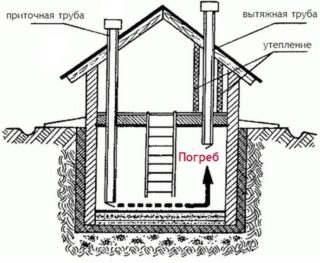
Before installing any of the described ventilation systems, you will need to familiarize yourself with the recommendations:
- It will be correct if the hood in the cellar is equipped directly during its construction. In this case, when laying out the walls, holes are immediately left into which ventilation pipes are subsequently installed.
- It is preferable to choose pipes with the same diameter, which guarantees uniform movement of air masses.
- If it is necessary to speed up the process of removing air saturated with dampness from the basement, the exhaust pipe is chosen a little wider than the supply pipe.
It is strictly forbidden to make an exhaust hood already of the inflow, since the air in this case will be retained within the basement. This negatively affects the condition of the products stored in the cellar and threatens the health of a person entering a gas-polluted space.
Do not place both ventilation pipes next to each other, this prevents good ventilation of the room. It is recommended to lay them along opposite walls and corners. Thanks to this, the fresh air flow before going out into the street captures almost the entire space and pulls out stagnant layers with it.
The hole for the chimney is made directly under the ceiling, since the warm, gassed air rushes upward and no stagnation forms there. In order to obtain good draft, the outlet ventilation pipe rises as high as possible (above the ridge or above the ceiling embankment of the cellar by at least 150 cm). For this part of the ventilation circuit, typical plastic pipes are selected that are used in the arrangement of sewage systems.
If the basement is located directly under the garage or under another household object, an entrance hatch is used as an exhaust hole. In this case, you will have to make two doors, one of which is insulated and intended for winter, and the second has a frame structure and is equipped with a grill. The latter is necessary to protect against penetration of small rodents into the basement.
Advantages and disadvantages
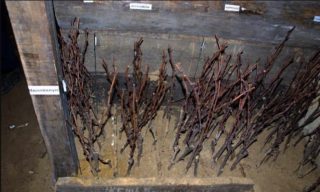
The positive aspects of arranging ventilation systems in the basement and in the area of the basement of buildings include:
- guaranteed provision of a comfortable microclimate in the house and no traces of dampness on the ground floor;
- ease of use of the storage room, in which a stable temperature is maintained, and the moisture content in the air does not exceed the prescribed norm;
- extension of the service life of the wooden supporting structures of a residential building.
In a ventilated basement, you can, if desired, install the simplest heating device and exclude the possibility of the accumulation of pathogenic mold spores that cause diseases of varying degrees of danger.
Installation rules for air ducts
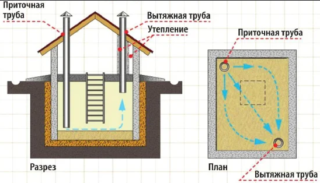
The basement hood is installed in accordance with current regulations and taking into account the following technical requirements:
- Air ducts are installed in such a way that there are as few sharp turns and bends as possible along the pipe route.
- The further the pipes are located relative to each other, the better the conditions for air circulation throughout the basement space.
- The chimney should be installed in one of the corners of the basement.
It is recommended to fasten the exhaust duct to the ceiling, taking into account that during laying, the end section of the line is at a height of at least half a meter from the top point of the structure. The supply channel is located on the opposite side at a distance of 0.2–0.4 meters from the foundation. Optimal conditions for normal natural air exchange are created by pipe lines with a billet diameter of 12-15 cm. Their lower part is located at the ceiling itself (at a height of at least 1.5 meters from the floor), which allows the heated air to go out completely. The air duct from the basement passes through all the upper rooms and is led out to the roof, where it is installed in such a way that its top rises 1.5 meters above the ridge.
Outdoor installation
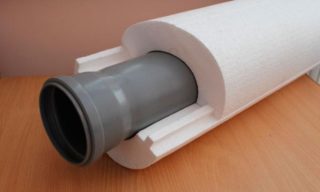
When air masses pass through the section of the pipe located on the street, condensate accumulates inside, and frost may form in winter. This can be avoided if this part of the common duct is well insulated. For this purpose, a larger pipe billet is put on the main structure, and the resulting gap is filled with insulation (mineral wool, for example).
The outlet of the ventilation system must be closed with a fine protective mesh. It is even better to install a special ventilation deflector on the pipe head, due to which an artificial vacuum is formed around the outlet channel (this helps to raise the draft). If the supply air duct for a system with a deflector is laid through the roof, its intake opening is made at least one meter below the cut of the exhaust pipe.Only if these conditions are met is it possible to obtain a significant pressure difference between the inlet and outlet, which helps to raise the thrust and improve the inflow of air masses. In combination with the effect obtained by using a deflector, this will significantly increase the rate of air exchange.
Often, when independently arranging basement ventilation under a private house, the supply channel is led out through a hole made in the ceiling or in the load-bearing wall of the building. In this case, a fine mesh (lattice) is necessarily put on the outside of its branch pipe, excluding the possibility of dust and debris getting into the internal spaces. In addition, it protects the ventilation duct from rodents.
In the inner space of the basement, in each branch of the air duct, dampers of a special design are mounted, opening or closing which it is possible to change the intensity of air flows. This guarantees the creation of the necessary microclimate necessary for the long-term storage of household utensils and canned food.








